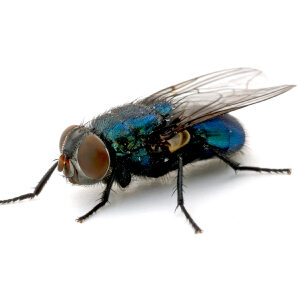Green Bottle Fly
These flies are bright green and have a metallic sheen.
Nesting Habits
These flies are usually the first insects to arrive and infest an animal after it dies. The larvae of green bottle flies are often used by forensic entomologists to help determine the time of death in murder cases.
Generally, these flies are most active on warm, sunny days and rest on cool and/or cloudy days. Indoors they are attracted to the bright light from windows, as well as certain light bulbs.
Dead rodents, birds and other small animals can be the source of flies within structures, while dog excrement, garbage and compost piles are common outdoor sources.
Damage
Because they are attracted to animal excrement and freshly dead materials, these flies may transfer pathogenic bacteria from one material to another. For example, Salmonella is easily carried on the feet of green bottle flies from dog droppings outdoors to meat or other foods.
Common Characteristics
Color
| Shiny, usually metallic green. |
Common Length
1/4-3/8 of an inch (6-9.5 millimeters)
Adults measure 1/4-3/8 of an inch (6-9.5 millimeters) long; thorax and abdomen shiny, usually metallic green, thorax without stripes.
Throughout North America.
Filth such as human excrement and sewage, fresh animal droppings and carcasses, decaying vegetation, and garbage.
Females lay about 180 eggs at one time; more than 2,000 in a lifetime. Depending on temperatures, eggs can hatch within eight to 42 hours, but will not hatch if temperatures are above 99°F/37°C. Developmental time (egg to adult) may require 10 days or more.
Excluding filthy green bottle flies from a facility is a challenge in the summer, especially when they can fly from breeding materials miles away.
Related Blog Posts
Flying Insects That Love Your Business
The sight of flies buzzing around your business can turn customers away and put your...
Read More
Pest Management Considerations After Flooding
The severe flooding parts of the country have experienced over the last couple of months...
Read More
Reduce Pest Attractiveness with Lighting Scheme Modifications
By Bennett Jordan,Ph.D., BCE, excerpt from 2017 PRSM Best Practices CHALLENGE Retail stores need lighting...
Read More
Tech Talk – Fruit Fly Management In a Commercial Setting
By Daniel Hill When handling fruit flies, how many times have you said to a...
Read More
Maggots and Flies – Connecting the Dots
The fly you see buzzing around inside may represent far more of a problem than...
Read More
Commercial Lighting Solutions to Combat Night-Flying Pests
Outdoor lighting plays a big part in commercial pest control. In fact, the wrong lighting...
Read More
[Tech Talk] What’s All the Buzz About?
I consider myself both a good entomologist and an ever-evolving backyard beekeeper. So imagine my...
Read More
[Tech Talk] Making the Most of All Four Seasons
By Bill Kolbe, BCE If bad winters sound discouraging, watch the award-winning movie March of...
Read More
August Is Fly Month With Copesan
This is a busy time of year for the green bottle fly, the house fly...
Read More
Drain Flies And Your Business
As most business owners know, drain flies can be a real nuisance. These flies breed...
Read More
[Tech Talk] You Too Can Relocate Honey Bee Swarms and Nucleus Colonies
Well before commercial pesticide applicators came under scrutiny as the result of honey bee colony...
Read More
Protect Your Business From Aggressive Yellowjackets
The month of September is the time of year for yellowjackets. These stinging insects live...
Read More
The Dangers Of Flies In Commercial Establishments
Flies are very common pests and can be found just about anywhere; however, this does...
Read More
The Increased Threat Of Stinging Insects In Late Summer
Why Do These Bugs Come Out in Late Summer? Stinging insects can be seen all...
Read More
Important Fly Prevention Tips For Business Owners
Flies are nuisance pests, but in a commercial environment they can become a severe problem...
Read More
The Buzz On Bottle Flies
In commercial facilities, bottle flies can quickly become a problem. These large flies are known...
Read More
Changing Insecticide Labeling in Regards to Pollinators
Author’s note: This column was written prior to the release of a recent report by USDA....
Read More
How To Prevent Stinging Insects On Site
No matter what the species or size, seeing a stinging insect is enough to put...
Read More

